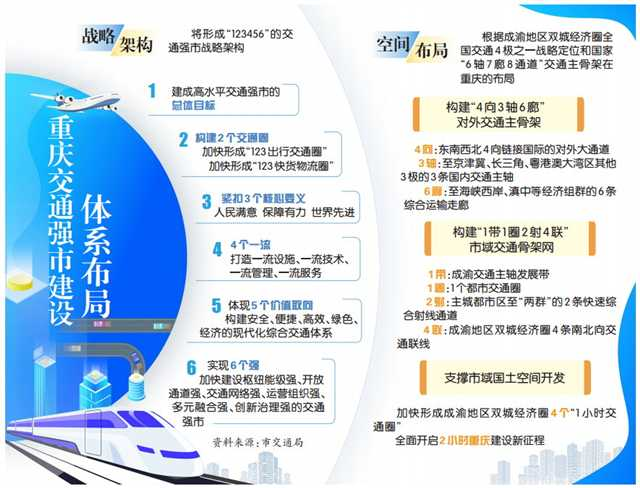Chongqing News
Traveling distance to be reduced to three hours between Chongqing and neighboring provincial capitals and six hours between Chongqing and first-tier cities by 2027
2023-11-15 15:06:22

CHONGQING (CQNEWS) -- As of the end of September this year, Chongqing has invested CNY490.23 billion in transport since the construction of a strong transportation city started two years ago. It is expected that by the end of this year, the total investment will amount to CNY 529.31 billion, exceeding the growth target and becoming a significant driving force to stimulate investment growth in Chongqing, according to the Chongqing Municipal Administration of Transportation.
26 waterways, highways, and railroads were built to connect Sichuan and Chongqing
Since the implementation of the construction of a strong transportation city, 15 key projects have started, and 16 key projects have been completed in Chongqing.
The construction of these key transportation projects has promoted the “Five-in-one” development of transportation in the Chengdu-Chongqing economic circle, which incorporates planning, construction, hubs, operation, and governance. So far, 26 transport channels have been built to connect Sichuan and Chongqing, including 16 highways, six railroads, and four waterway corridors, which enable one hour’s traveling distance between Chongqing and most neighboring cities in Sichuan. It takes one hour to travel from Chongqing to Chengdu. There are an average of 125 pairs of trains and 22 cross-provincial bus lines running between Sichuan and Chongqing every day.
The railroads under construction amount to nearly 1,000 kilometers
Since 2021, the total length of the railroads in operation in Chongqing has increased by 400 kilometers, of which 184 kilometers are covered by high-speed railways. The ‘米’-shaped high-speed railway network in operation exceeds 1,000 kilometers, hitting a new record high. The rapid development of railroads significantly has enhanced the travel efficiency for passengers, with the traveling distance between downtown Chongqing and Wushan shortened to 2 hours from 4 hours, the traveling distance between downtown Chongqing and Zhengzhou reduced to 4 hours from 8 hours, and the traveling distance between downtown Chongqing and Beijing reduced to 7 hours from 11 hours.
The rail transit system in operation has exceeded 500 kilometers. Specifically, 288 bus routes were added or adjusted, and 38 lane bus routes were opened in the downtown area. The rail transit passengers account for 52% of the total passengers.
In terms of highways, the goal of "connecting different counties through highways" has been achieved. The total length of highways in operation has surpassed 4,000 kilometers, showing an increase of 600 kilometers. The highway system, consisting of three ring roads, 14 rays, and several interconnected routes, ranked first in western China in terms of coverage.
Besides, the shipping center in the upper reaches of the Yangtze River has taken shape, with its function improved at a faster pace. 300-kilometer 1000-ton waterways have improved, and the total length of the waterways reached 1,100 kilometers; the cargo handling capacity of the ports has increased to 210 million tons by 5 million tons; more than 45% of the ports' cargo came from surrounding provinces and cities.
160 major projects are planned for the next five years
In the next five years, Chongqing will plan and implement 160 major projects to further accelerate the construction of a powerful transport city.
By 2027, Chongqing strives to complete the construction of six high-speed railways, which include the Chongqing-Qianjiang section of the Chongqing-Hunan High-speed Railway, the second Chengdu-Chongqing High-speed Railway, the Chongqing-Kunming High-speed Railway, the Chengdu-Dazhou-Wanzhou High-speed Railway, the Chongqing-Wanzhou High-Speed Railway, and the Xi'an-Chongqing High-speed Railway. At the same time, Chongqing will start the construction of four high-speed railroads totaling 520 kilometers, which include the Chongqing-Yichang High-speed Railway, the Qianjiang-Jishou High-Speed Railway, the Jiulongpo-Chongqingdong Railway Station direct line, and the Chongqing-Guiyang High-speed Railway. Chongqing will also start constructing a 130-kilometer west railway loop line and prepare for constructing the Lanzhou-Chongqing high-speed railway and the Wanzhou-Qianjiang high-speed railway.
Chongqing will expand the Yangtze River Golden Waterway by adding 200 kilometers of 1,000-ton waterways (total length will reach 1,300 kilometers) and strive to start the construction of new waterways for water transport along the Three Gorges during the 14th Five-Year Plan period. Chongqing will accelerate the improvement of branch waterways and the construction of port clusters, to increase the cargo handling capacity of ports by 40 million tons to 250 million tons.
What’s more, Chongqing will speed up the construction of the fast road network consisting of eight horizontal roads, seven vertical roads, one ring road, and nine interconnected roads. Efforts will be made to build 1000-kilometer new city roads (total length will reach 7,300 kilometers) and strengthen the connection of fast roads inside and outside Chongqing. In terms of Chongqing rail transit, efforts will be made to extend the coverage of CRT lines and accelerate the building of Bishan-Tongliang lines and Yongchuan lines, to form a one-hour commuting circle in downtown Chongqing.
By 2027, Chongqing, as an international comprehensive transport hub, will upgrade its energy level, demonstrate the combined benefits of multimodal transport hubs, and significantly increase its influence in western China. At the same time, a modern comprehensive multi-level traffic network will be completed in Chongqing, providing four one-hour traffic circles in the Chengdu-Chongqing economic circle and western Chongqing and a two-hour traffic circle within Chongqing, and reducing the traveling distance between Chongqing and neighboring provincial capitals to three hours, and the traveling distance between Chongqing and first-tier cities to six hours. By 2035, Chongqing will develop into a strong transport city; transport will make a greater contribution to the construction of a modern Chongqing and the pioneer for the construction of new Chongqing in the new era. (Translated by Yuki, Fathom Language Limited)
Editor:Jiang Yiwei
 手机阅读分享话题
手机阅读分享话题